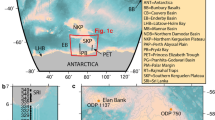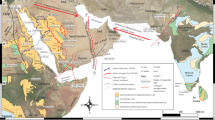Abstract
The breakup of the supercontinent Gondwanaland into Africa, Antarctica, Australia and India about 140 million years ago, and consequently the opening of the Indian Ocean, is thought to have been caused by heating of the lithosphere from below by a large plume whose relicts are now the Marion, Kerguelen and Réunion plumes. Plate reconstructions based on palaeomagnetic data suggest that the Indian plate attained a very high speed (18–20 cm yr-1 during the late Cretaceous period) subsequent to its breakup from Gondwanaland, and then slowed to ∼5 cm yr-1 after the continental collision with Asia ∼50 Myr ago1,2. The Australian and African plates moved comparatively less distance and at much lower speeds of 2–4 cm yr-1 (refs 3–5). Antarctica remained almost stationary. This mobility makes India unique among the fragments of Gondwanaland. Here we propose that when the fragments of Gondwanaland were separated by the plume, the penetration of their lithospheric roots into the asthenosphere were important in determining their speed. We estimated the thickness of the lithospheric plates of the different fragments of Gondwanaland around the Indian Ocean by using the shear-wave receiver function technique. We found that the fragment of Gondwanaland with clearly the thinnest lithosphere is India. The lithospheric roots in South Africa, Australia and Antarctica are between 180 and 300 km deep, whereas the Indian lithosphere extends only about 100 km deep. We infer that the plume that partitioned Gondwanaland may have also melted the lower half of the Indian lithosphere, thus permitting faster motion due to ridge push or slab pull.
This is a preview of subscription content, access via your institution
Access options
Subscribe to this journal
Receive 51 print issues and online access
$199.00 per year
only $3.90 per issue
Buy this article
- Purchase on Springer Link
- Instant access to full article PDF
Prices may be subject to local taxes which are calculated during checkout




Similar content being viewed by others
References
Klootwijk, C. T., Gee, J. S., Peirce, J. W. & Smith, G. M. An early India–Asia contact: Paleomagnetic constraints from Ninetyeast Ridge, ODP Leg 121. Geology 20, 395–398 (1992)
Gaina, C., Müller, R. D., Brown, B. & Ishihara, T. Breakup and early seafloor spreading between India and Antarctica. Geophys. J. Int. 170, 151–169 (2007)
Veevers, J. J. Breakup of Australia and Antarctica estimated as mid-Cretaceous (95 ± 5 Ma) from magnetic and seismic data at the continental margin. Earth Planet. Sci. Lett. 77, 91–99 (1986)
Cande, S. C. & Mutter, J. C. A revised identification of the oldest sea-floor spreading anomalies between Australia and Antarctica. Earth Planet. Sci. Lett. 58, 151–160 (1982)
Jacoby, W. R. in Landolt-Bornstein, New Series, Group V Vol. 2b (eds Fuchs, K. & Soffel, H.) 298–369 (Springer, Berlin, 1985)
Barrell, J. The strength of the Earth’s crust. J. Geol. 22, 655–683 (1914)
Anderson, D. L. Lithosphere, asthenosphere, and perisphere. Rev. Geophys. 33, 125–149 (1995)
Gutenberg, B. Physics of the Earth’s Interior. (Elsevier, New York, 1959)
Jordan, T. H. The continental tectosphere. Rev. Geophys. Space Phys. 13, 1–13 (1975)
James, D. E., Fouch, M. J., VanDecar, J. C. & van der Lee, S. Tectospheric structure beneath southern Africa. Geophys. Res. Lett. 28, 2485–2488 (2001)
Li, X., Kind, R., Yuan, X., Wölbern, I. & Hanka, W. Rejuvenation of the lithosphere by the Hawaiian plume. Nature 427, 827–829 (2004)
Kumar, P. et al. The lithosphere–asthenosphere boundary in the North West Atlantic Region. Earth Planet. Sci. Lett. 236, 249–257 (2005)
Kumar, P., Yuan, X., Kind, R. & Kosarev, G. The lithosphere–asthenosphere boundary in the Tien Shan-Karakoram region from S receiver functions—evidence of continental subduction. Geophys. Res. Lett. 32 L07305 doi: 10.1029/2004GL022291 (2005)
Kumar, P., Yuan, X., Kind, R. & Ni, J. Imaging the colliding Indian and Asian lithospheric plates beneath Tibet. J. Geophys. Res. 111, B06308 10.1029/2005JB003930. (2006)
Sodoudi, F., Yuan, X., Liu, Q., Kind, R. & Chen, J. Lithospheric thickness beneath the Dabie Shan, central eastern China from S receiver functions. Geophys. J. Int. 166, 1363–1367 (2006)
Angus, D. A., Wilson, D. C., Sandvol, E. & Ni, J. F. Lithospheric structure of the Arabian and Eurasian collision zone in eastern Turkey from S-wave receiver functions. Geophys. J. Int. 166, 1335–1346 (2006)
Landes, M., Ritter, J. R. R. & Readman, P. W. Proto-Iceland plume caused thinning of Irish lithosphere. Earth Planet. Sci. Lett. 255, 32–40 (2007)
Li, X., Yuan, X. & Kind, R. The lithosphere–asthenosphere boundary beneath the western United States. Geophys. J. Int. 170, 700–710 (2007)
Li, X. et al. Seismic observation of narrow plumes in the oceanic upper mantle. Geophys. Res. Lett. 30 (6). 1334 doi: 10.1029/2002GL015411 (2003)
Polet, J. & Anderson, D. L. Depth extent of cratons as inferred from tomographic studies. Geology 23, 205–208 (1995)
Mitra, S., Priestley, K., Gaur, V. K. & Rai, S. S. Shear-wave structure of the south Indian lithosphere from Rayleigh wave phase–velocity measurements. Bull. Seism. Soc. Am. 96, 1551–1559 (2006)
Pandey, O. P. & Agarwal, P. K. Lithospheric mantle deformation beneath the Indian cratons. J. Geol. 107, 683–692 (1999)
Artemieva, I. M. Global 1 degree × 1 degree thermal model TC1 for the continental lithosphere: Implications for lithosphere secular evolution. Tectonophysics 416, 245–277 (2006)
Priestley, K. & McKenzie, D. The thermal structure of the lithosphere from shear velocities. Earth Planet. Sci. Lett. 244, 285–301 (2006)
Mezger, K. & Cosca, M. A. The thermal history of the Eastern Ghats belt (India) as revealed by U–Pb and 40Ar/39Ar dating of metamorphic and magmatic minerals: implications for the SWEAT correlation. Precambr. Res. 94, 251–271 (1999)
Kumar, A., Padma Kumari, V. M., Dayal, A. M., Murty, D. S. N. & Gopalan, K. Rb–Sr ages of Proterozoic Kimberlites of India: evidence for contemporaneous emplacement. Precambr. Res. 62, 227–237 (1993)
Ingle, S., Scoates, J. S., Weis, D., Brügmann, G. & Kent, R. W. Origin of Cretaceous continental tholeiites in southwestern Australia and eastern India: insights from Hf and Os isotopes. Chem. Geol. 209, 83–106 (2004)
Coffin, M. et al. Kerguelen hotspot magma output since 130 Ma. J. Petrol. 43, 1121–1139 (2002)
Jurdy, D. M. & Gordon, R. G. Global plate motions relative to the hotspots 64 to 56 Ma. J. Geophys. Res. 89, 9927–9936 (1984)
Gurnis, M. & Torsvik, T. H. Rapid drift of large continents during the late Precambrian and Paleozoic: Paleomagnetic constraints and dynamic models. Geology 22, 1023–1026 (1994)
Gaherty, J. B., Mamoru, K. & Jordan, T. H. Seismological structure of the upper mantle: a regional comparison of seismic layering. Phys. Earth Planet. Inter. 110, 21–41 (1999)
Ritsema, J., Nyblade, A. A., Owens, T. J., Langston, C. A. & VanDecar, J. C. Upper mantle seismic velocity structure beneath Tanzania, east Africa: Implications for the stability of cratonic lithosphere. J. Geophys. Res. 103 (B9). 21201–21214 (1998)
Frederiksen, A. W. & Bostock, M. G. Modelling teleseismic waves in dipping anisotropic structures. Geophys. J. Int. 141, 401–412 (2000)
Acknowledgements
We thank J. Phipps Morgan, L. Brown, D. Eaton and D. Mueller for helpful comments. This research was supported by the Deutsche Forschungsgemeinschaft. P.K. was supported by a DAAD Fellowship under which part of this work was performed at GeoForschungsZentrum. The director of the National Geophysical Research Institute is thanked for his support. Seismic data for most of the stations are available through the open data archives of IRIS (http://www.iris.edu/), GEOFON (http://www.gfz-potsdam.de/geofon/) and GEOSCOPE (http://geoscope.ipgp.jussieu.fr/), and Indian stations are supported by the Department of Science and Technology and IMD, India. Seismic data analysis was performed in SeismicHandler (K. Stammler).
Author information
Authors and Affiliations
Corresponding author
Ethics declarations
Competing interests
The authors declare no competing financial interests.
Supplementary information
Supplementary Information
The file contains Supplementary Table S1 and Supplementary Figures S1-S6 with Legends. (PDF 1708 kb)
Rights and permissions
About this article
Cite this article
Kumar, P., Yuan, X., Kumar, M. et al. The rapid drift of the Indian tectonic plate. Nature 449, 894–897 (2007). https://doi.org/10.1038/nature06214
Received:
Accepted:
Issue Date:
DOI: https://doi.org/10.1038/nature06214
This article is cited by
-
Imaging of Different Crustal and Mantle Discontinuities Below the Hyderabad Region on the Eastern Dharwar Craton
Pure and Applied Geophysics (2024)
-
Mechanical strength characterization and seismic performance of rammed earthen walls built on eco-friendly lateritic soil and sustainable stabilizing materials
Sādhanā (2024)
-
On the possible primary sources of Koh-i-Noor and other Golkonda diamonds
Journal of Earth System Science (2024)
-
Three-dimensional Moho depth model of the eastern Indian shield and its isostatic implications
Journal of Earth System Science (2023)
-
The Paleozoic Central Patagonian Igneous Metamorphic Belt: its geodynamic and tectonic interpretation based on paleogeographic reconstructions
International Journal of Earth Sciences (2023)
Comments
By submitting a comment you agree to abide by our Terms and Community Guidelines. If you find something abusive or that does not comply with our terms or guidelines please flag it as inappropriate.



